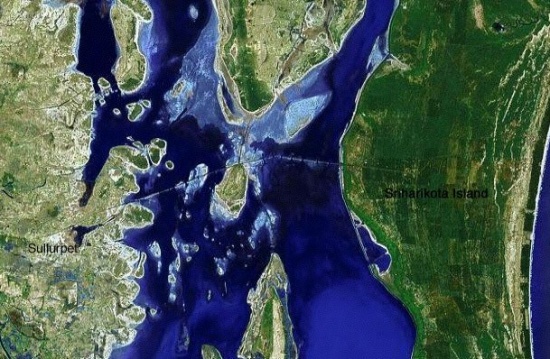Overview
Pulicat Lake is a quite large lagoon, open to the sea in South India. The larger part lies in Andhra Pradesh, the smaller southern part in Tamil Nadu. Varying according to the rainfall, the lake can take more than 700sqkm, but in summer large parts fall dry.
Birds
Notable Species
Ducks (mainly Eurasian Wigeon, Northern Pintail and Northern Shoveler, but anything possible), Pied Cuckoo
Waders (including hard to separate Red-necked Stint, Pied Avocet, Black-winged Stilt, Pacific Golden Plover and Grey-headed Lapwing), Gulls and Terns, Osprey, Harriers, Cormorants, Egrets, Greater Flamingo, Lesser Flamingo (hard to find), Black-headed Ibis and Glossy Ibis, Spot-billed Pelican, Painted Stork, Ashy Woodswallow
Passerines include Richard's Pipit and Blyth's Pipit, but the area is underwatched and has a great potential for rarities and vagrants!
Check-list
Birds you can see here include:
To do
Other Wildlife
To do
Site Information
Best between November and March. The size of the lake is variable and depends on the monsoon. In March the northern part may be dry.
History and Use
To do
Areas of Interest
There are several places to be explored, best seemed to me the road from Sullurpet to Sriharikota Island. Take the National Highway 5 from Chennai north. Pass Ponneri, Tada and the first sign for Sullurpet. After another km a second sign to the right indicates "Sriharikota". Follow the sign and cross the small town of Sullurpet. The road turns left and soon after the town there are some fine marshes to the left. They can be easily explored from the road (Telescope is a must in the whole area).
If you follow the road further, there is some grass- and bushland to the right which is good for Pied Cuckoo and Pipits. Waders are abundant.
Further out there may be water to both sides of the road and big mudflats with thousands of Stints and Plovers. There is one road going to the right, but you need a good car to follow it. Finally you reach Sriharikota island, but you better be careful with telescopes and binoculars as it is a Space Research Centre.
Access and Facilities
You can reach the site from Chennai (formerly known as Madras), the capital of Tamil Nadu.
If you take a taxi from Chennai (costs about 2000 to 2500 Rs) make sure that he has a permit to enter the state of Andrha Pradesh (can be obtained by the driver or he has an all Indian permit).
The site can be reached by car in a day from Chennai, where various acccomodation can be found. There are some small and basic places in Sullurpet and Tada and a Forest Rest House at Pulicat, at the southern tip of the lake which is not so interesting for birds. There are some basic restaurants and foodstalls in Sullurpet, but best is to bring food and water with you to spend more time in the field.
Contact Details
To do
External Links
To do
Content and images originally posted by wintibird
Reviews
texastwo's review
I just went to Pulicat lake last weekend, Saturday Feb 11, 2006. Supposedly there was the first ever Flamingo Festival at Pulicat Lake just a week earlier.
We drove on a nice paved road that went towards Sriharikota to the east from NH5. There was very little water in the lake bed. It was mostly dry and barren. We took at turn towards the south on a very rough unpaved road and followed the dry lake bed for 8kms. No water was to be found except for a few scattered washes and streams. I am not sure if low tide had anything to do with it or it was too late in the season. Why have a Flamingo Festival if there are no flamingoes? Doesn't make sense.
NO flamingos..and no information where they were at. I saw one blue tailed bee eater and one white-throated kingfisher, and a couple white egrets.
I sent emails to the organizers of the Flamingo Festival before my departure but unfortunately they did not respond.
Information on the net says that the Flamingos stay till April.
Very disappointed with how that one turned out. :(
Pros
- none
Cons
- large dry and barren lake bed
wintibird's review
As written above at the end of the season the northern part may fall dry (this has nothing to do with tide). Usually Flamingos can be found then near Tada or even more to the south. More informations in "A Birdwatcher's Guide to India" by Kazmierczak and Singh.





